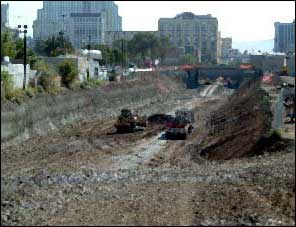















Successes in Stewardship: October 2004 |
|---|

|
Federal Highway Administration
October 2004
Nevada's ReTRAC.info: Real-time Project Compliance information on the Web

ReTRAC's below-grade rail corridor will reach a center depth of approximately 33 feet. The City of Reno developed ReTRAC.info, an online resource that provides the public with real-time reports on the project's compliance with Nevada DOT's environmental commitments.
For more than 140 years, railroad tracks located in downtown Reno, Nevada, disrupted the flow of vehicle and pedestrian traffic. As the numbers of residents, visitors, and vehicles have risen, so have related traffic, public safety, and environmental problems. In 1995, projections of increased rail traffic prompted the City of Reno (subsequently referred to as the "City") to revisit a solution that has been proposed several times in the past: to depress a 2.3-mile section of track located in the central downtown area. The resulting project, Reno Transportation Rail Access Corridor (ReTRAC), is a below-grade corridor that will reach a center depth of approximately 33 feet. Eleven at-grade, street-railway crossings will be replaced with "bridges" across the top of the trench. Rail service will be maintained during construction via a temporary bypass route constructed adjacent to the existing mainline tracks.
In its early stages, ReTRAC was hotly contested; some questioned its fiscal viability and others predicted that the project itself would cause negative environmental impacts. The City and the Nevada Department of Transportation (NDOT) recognized that addressing these issues would be necessary in order to gain the support of cooperating agencies, the City Council, and public at large. Furthermore, ReTRAC costs needed to be kept to a minimum to ensure City Council approval for the project.
The City's approach to the controversy surrounding ReTRAC was to treat all stakeholders as partners and to provide them with continuous, accurate, and up-to-date mitigation monitoring information. The City developed ReTRAC.info (also called the ReTRAC Mitigation Monitoring Program Report System), an online resource that provides the public with real-time reports on the project's compliance with NDOT's environmental commitments.
In addition to improving environmental quality, ReTRAC.info was also designed to conserve project resources. Previously, monitors in the field would write notes on paper and return to the office to upload the data into the project database, essentially recording the same information twice. Using ReTRAC.info, monitors can upload field reports directly from the field. The monitors carry hand-held devices with them as they conduct their field surveys and upload their data to the Internet via wireless communication technologies. City officials estimate that ReTRAC.info saves each monitor 45 minutes each day per report filed.
|
User Friendly ReTRAC.info
|
Documents compiled in ReTRAC.info include:
City environmental consultants emphasize the significance of compliance reports, which provide positive feedback to contractors when they are performing as expected. One project principal noted that it is important to "change the mindset from being monitoring police to partners." So far, only one non-compliance report has been filed on ReTRAC.info. In addition, the State Historic Preservation Office, the Nevada Department of Environmental Protection, and permitting agencies can give feedback online and access sensitive cultural resource data that is not available to the general public.
ReTRAC.info provides current, higher quality information to the public and cooperating agencies at less cost. Based on the calculation that ReTRAC.info saves each monitor 45 minutes each day per report filed, City officials estimate that the system recouped its capital investment costs within six months of its September 2002 implementation. Furthermore, the savings will continue, since system maintenance requires very little funding. Other savings are realized from a streamlined process for drafting the monthly, quarterly, and annual project reports. In the past, City consultants sorted through hundreds of paper reports when compiling these routine documents. Now that all reports are electronic and located in one central repository, dozens of hours are saved on this task.
|
Replicating ReTRAC.info
ReTRAC.info can be replicated in other States. In urban areas, wireless networks may already be in place that could be used to upload mitigation data. In rural areas, installation of an antenna would allow use of either a stand-alone local area network or connection to the Web via existing telephone service. ReTRAC.info is non-proprietary, and the agencies encourage others to contact them to discuss adapting it for use in other areas.
|
The benefits of ReTRAC.info are more than just financial. The immediacy and accessibility of ReTRAC.info helps ensure greater compliance with environmental commitments by eliminating some typical stumbling blocks. Because the Web site makes the mitigation reports immediately available to the project compliance managers, the process time between a non-compliant construction activity and corrective action is shortened from days to hours. Therefore, any incentive for non-compliance has vanished, and the construction contractors are better motivated to utilize sound techniques to minimize contractor-caused project delays. In addition, immediate report uploading from the field avoids problems associated with lost, misplaced, or misdirected hard copies.
Judging by the reduced number of compliance calls from the public, ReTRAC.info is working. According to City staff, they are receiving fewer public complaints than expected because 1) people can access more of the information they want electronically and 2) by providing the public with a window on environmental monitoring, reporting, and follow-up, ReTRAC.info demonstrates that NDOT and the City are concerned and effective environmental stewards. In the words of one City official, you can "never put too much information in front of the public."
Through the process of developing ReTRAC.info, NDOT and the City have learned the following lessons:
| Visit http://www.retrac.info/ for more information.
Ted Bendure, Environmental Program Manager |
|
|
